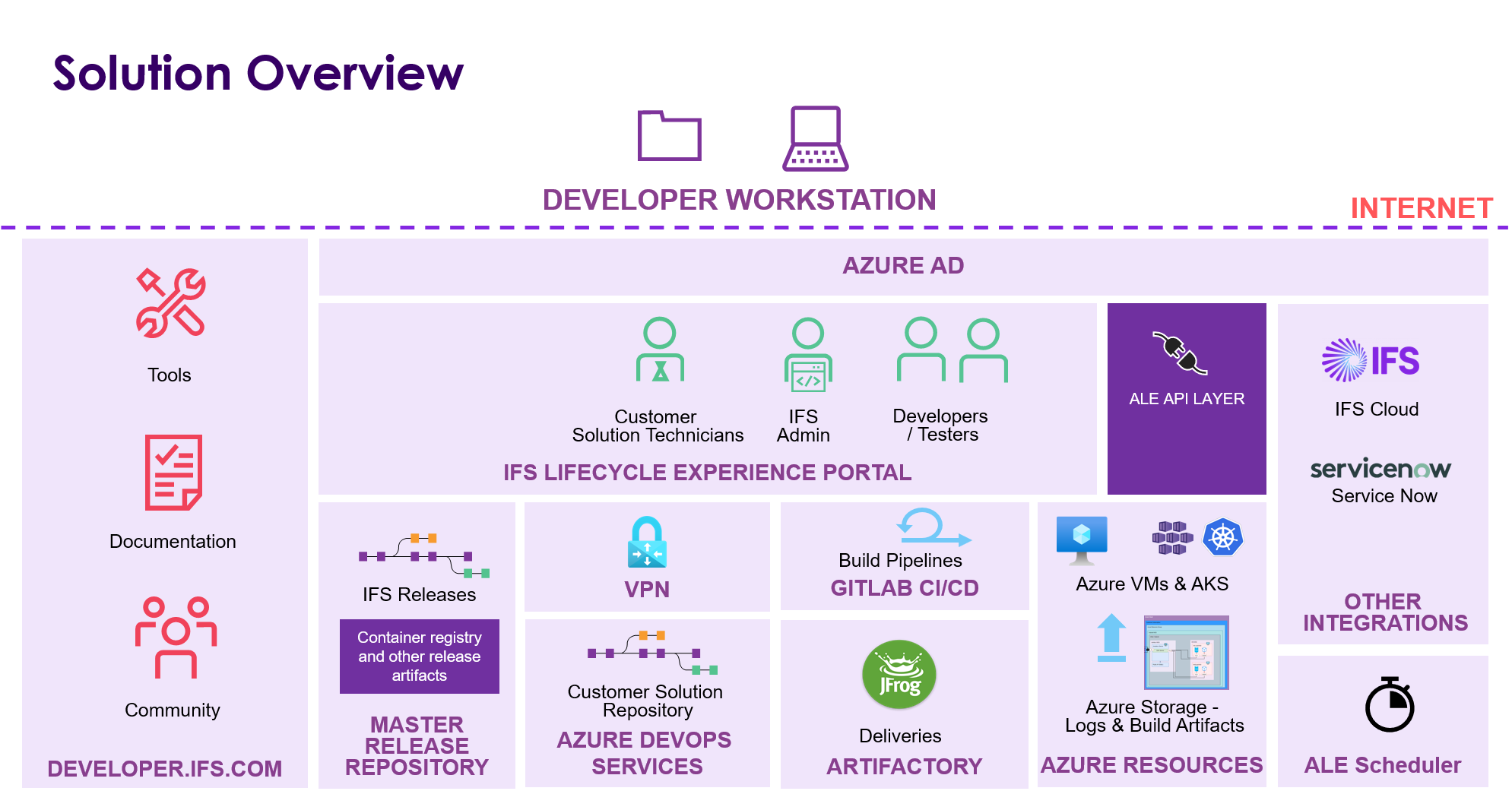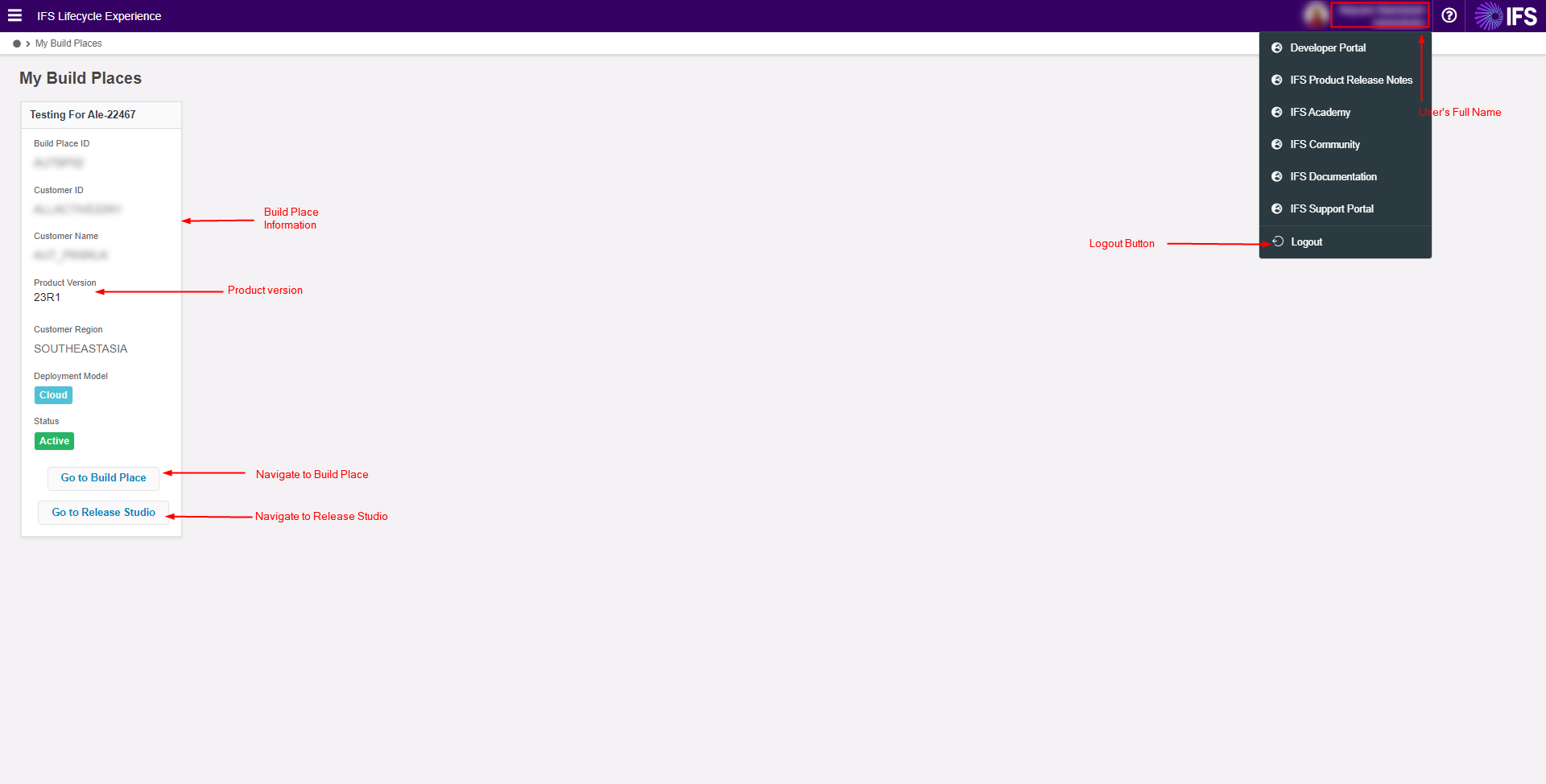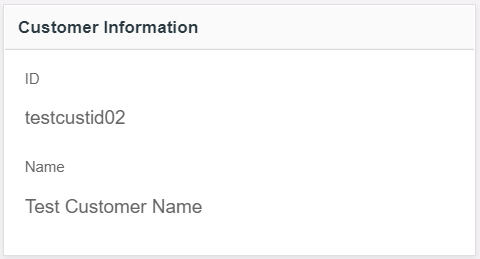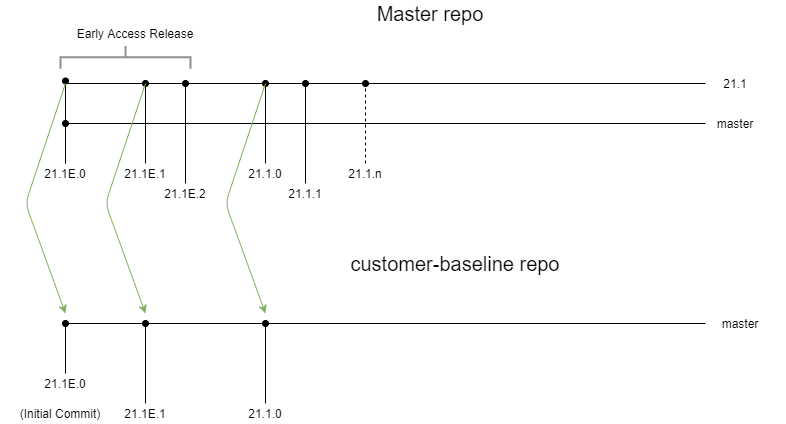Overview¶
There are 7 strategic pillars for individual moments of service for customer engagement which is explained in the diagram below. This is the user journey that IFS envisage our IFS Cloud customers to go through from first touch point upto live deployment of the solution.
The Lifecycle Experience section of the documentation is related to design and delivery stages of this journey.

Some Terminology¶
Customer Solution:¶
Prior to 22R2: Refers to the entire code base which consists of core IFS components and any customer specific code developed by the customer.
22R2 & Beyond: Refers to the codebase which consists of customer specific code developed by the customer.
Customer Baseline:¶
Prior to 22R2: Refers to the code base which only consists of core IFS components. This includes any service or release updates of IFS Cloud applied to the code base.
22R2 & Beyond: Refers to the codebase which only consists IFS Cloud configuration files. This includes corresponding service/release update version maintenance, language translation and core IFS component configuration files.
Find the High-level architecture of the IFS Cloud in the "Architectural Overview" section of the Technical Documentation.
Main components of the Solution¶

The main components of the IFS Lifecycle Experience Solution are;
IFS Lifecycle Experience Portal - This Web Portal will serve as the main point of entry to the IFS Lifecycle Experience for the end-users of the system. Administrators will use the portal to setup, manage and decommission customer solutions. End users will use this portal to trigger actions related to customer solution development. Applying Service Updates released by IFS and investigate support issues related to software faults in the underlying product are also hosted in the solution.
Azure AD - Authentication to all the above components is managed through the IFS Azure Active Directory (Azure AD). All users accessing the system requires to be onboarded to the Azure AD prior to gaining relevant role-based access to the Lifecycle Experience functionality.
IFS Developer portal - The IFS Developer portal is published on developer.ifs.com. The Customer Solution Developers will download the IFS Developer tools required for development on IFS Cloud from the developer portal to their local workstations.
IFS Cloud Master Repository - Contains all the source files for IFS Cloud core releases.
VPN - Before accessing the database of a build place environment, a connection to the build place via Azure VPN gateway needs to be established from the user's workstation.
Artifactory - ALE solution delivery artifacts, binaries, packages, files, logs, and containers are stored in the JFrog Artifactory. This functions as the central hub for storing and retrieving all key artifacts used within the Lifecycle Experience Platform.
GitLab CI/CD - The majority of the backend automation that is triggered via the LE portal and its integrations are orchestrated using the GitLab CI/CD pipelines, which build, deliver, and manage the infrastructure needed for the Lifecycle Experience.
Azure DevOps Services - This consists of Azure repositories hosting the customer solution and Azure build pipelines hosting some of the LE platform’s legacy automation.
Azure Resources - This comprises of resources belonging to the ALE Central resources as well as resources existing within customer subscriptions. The central ALE resources include the LE Web Portal, central table storage, key vaults, and container registries. The customer-specific resources consist of self-provisioned Azure VMs consisting of IFS Cloud Environments ordered by the users of the IFS Lifecyle Experience. These environments can be provisioned from different stages of the customer solution as requested by the user. Several Azure resource groups will be created per customer solution which groups the customer-specific resources under it.
Other Integrations - The Lifecycle Experience interacts with other services and platforms like the IFS Cloud and Service Now. The IFS Cloud is a web-based ERP solution and Service Now is used for onboarding customers, migrating deliveries to Use Place and for reporting disruption in services offered by IFS.
The 3 components - Azure Dev Ops Services, Azure Resources and the IFS Lifecycle Experience Portal together forms the Customer Solution Cloud Build Place.
User Authorization of the System¶
There are six different user roles in the Lifecycle Experience solution namely; Build Place User Admin, Technician, Customer Solution Developer, Customer Solution Consultant, IFS Product Support Developer, and IFS Product Support Consultant.
The following tables describe the user role permissions for the LE portal, Azure DevOps (ADO), and Release Update Studio.
User Role Permissions for LE Portal Functionality¶
Initial Build Place Related Activities¶
| BPUserAdmin | Technician | CustomerSolutionDev | CustomerSolutionConsultant | IFSProductSupportDev | IFSProductSupportConsultant | |
| BP Activation | Yes | No | No | No | No | No |
| Solution Set Update | Yes | No | No | No | No | No |
| BP Configuration of Implementation Mode | No | Yes | No | No | No | No |
Subsequent Build Place Related Activities¶
| BPUserAdmin | Technician | CustomerSolutionDev | CustomerSolutionConsultant | IFSProductSupportDev | IFSProductSupportConsultant | |
| Analyze Service Updates | No | Yes | Yes | No | Yes | No |
| Manual Sanity Build | No | Yes | No | No | No | No |
| Create Build Home | No | Yes | No | No | No | No |
Environment Management¶
| BPUserAdmin | Technician | CustomerSolutionDev | CustomerSolutionConsultant | IFSProductSupportDev | IFSProductSupportConsultant | |
| Build Place Environments (Topic, Dev, Baseline, QAS) | View, Create, Delete | View, Create, Delete | View, Create, Delete | View, Create, Delete | View, Create, Delete | View, Create, Delete |
| VM Power operations | Yes | Yes | Yes | Yes | Yes | Yes |
| Extend Environment Lifespan | No | Yes | No | No | No | No |
| Renew IFS Cloud Certificate | No | Yes | No | No | No | No |
Delivery and Deployment¶
| BPUserAdmin | Technician | CustomerSolutionDev | CustomerSolutionConsultant | IFSProductSupportDev | IFSProductSupportConsultant | |
| Create and Delete Deliveries | No | Yes | No | No | No | No |
| Approve Deliveries | Yes | Yes | Yes | Yes | Yes | Yes |
| Download delivery | Yes | Yes | Yes | Yes | Yes | Yes |
| Manage deployment | Yes | Yes | No | No | No | No |
| Generate password for Cloud Customers | Yes | Yes | No | No | No | No |
Operational Management¶
| BPUserAdmin | Technician | CustomerSolutionDev | CustomerSolutionConsultant | IFSProductSupportDev | IFSProductSupportConsultant | |
| Build Place Settings/Environments Quota | Read | Read | Read | Read | Read | Read |
| Build Place Settings/Change Daily Scheduled Shutdown Time | Read | Write | Read | Read | Read | Read |
| Build Place Settings/Remote Deployment Service Provider (Only for Remote BPs) | Read, Write | Read | Read | Read | Read | Read |
| Job Table | Yes | Yes | Yes | Yes | Yes | Yes |
| Build Place Translation | Read | Read, Write | Read | Read | Read | Read |
Azure DevOps (ADO)¶
| BPUserAdmin | Technician | CustomerSolutionDev | CustomerSolutionConsultant | IFSProductSupportDev | IFSProductSupportConsultant | |
| Customer Solution Repository (ADO) | No | Read, Write, Approve Pull Request, Merge | Read, Write, Approve Pull Request, Merge | No | Read | No |
| Customer Baseline Repository (ADO) | No | Read | Read | No | Read | No |
| Apply Service Updates to Baseline (ADO) | No | Yes | Yes | No | No | No |
| Apply Service Updates to Solution (ADO) | No | Yes | Yes | No | No | No |
Release Update Studio Related Activities¶
| BPUserAdmin | Technician | CustomerSolutionDev | CustomerSolutionConsultant | IFSProductSupportDev | IFSProductSupportConsultant | |
| Impact Assessment | Yes | Yes | Yes | Yes | Yes | Yes |
| Request Release Update | No | Yes | Yes | No | No | No |
| Apply Release Update in Baseline Repo | No | Yes | Yes | No | No | No |
| Customization Upliftment Preparation | No | Yes | Yes | No | No | No |
| Apply Release Update in Solution Repo | No | Yes | Yes | No | No | No |
| Impact Analysis | No | Yes | Yes | No | Yes | No |
| Release Update Studio Environments (Topic, Dev, Baseline) | View, Create, Delete | View, Create, Delete | View, Create, Delete | View, Create, Delete | View, Create, Delete | View, Create, Delete |
| Test Data Update (Applicable only for the Build Places that have Test Data Management feature enabled) | No | Yes | No | No | No | No |
| Complete Release Update Process / Cut-over | No | Yes | No | No | No | No |
Apart from the newly introduced functionality in the Release Update Studio, the overall functionality is similar to that of the Build Place, and grants similar user role permission sets.
Supporting Functionality¶
| BPUserAdmin | Technician | CustomerSolutionDev | CustomerSolutionConsultant | IFSProductSupportDev | IFSProductSupportConsultant | |
| Service Insight Studio | Yes | No | No | No | No | No |
| Service Access Studio | Yes | No | No | No | No | No |
IFS Lifecycle Experience Portal¶
When logging into the IFS Lifecycle Experience Portal, initially the user will be redirected to the IFS Azure Active directory login page to log into the portal. The User can log into the portal using his/her credentials which have been previously registered with IFS.

This is the "My Build Places" view (default home page) which will appear after the user logs into the portal

After selecting one of the available build places, the user can view the build-place details. The following images contain the sub-components in the build-place detail view.
Customer Information

Repository Information
Prior to 22R2:

22R2 & Beyond

VPN Details

Users who need access to the database or the Build Home of a Build Place Environment should first configure a connection to the Build Place VPN from the user workstation.
Build Place Environment Information

Logout

Repository Structure¶
The IFS Lifecycle Experience Cloud Build Place contains 2 repositories; Customer Baseline Repository and Customer Solution Repository.
Customer Baseline Repository¶
Prior to 22R2:
The Customer Baseline Repository is a clone of the master release repository. Initially, the customer's required version will be pulled from the master repository. The Customer Baseline will be tagged with the same tag presented when pulling from the master repository. The Customer Baseline will contain a single branch (master branch) and a single tag at the beginning. However, the number of tags will grow along with time. The Baseline Repository holds all the IFS components released for that specific version (tag). The merges to the master branch of the Customer Baseline does not require pull requests at any point. It is a read-only repository for all Build Place users. The update strategy of the Customer Baseline is straightforward. When there is a need for a new service update, an IFS Support Developer will pull that certain updated version from the master repository and push it directly to the customer baseline repository.
22R2 & Beyond:
The Customer Baseline Repository is a representation of core releases that have been taken to the Build Place. It contains meta files such as,
- fndbas/source/version.txt
- fndbas/solutionset.yaml
- fndbas/server/translation/translationusage.json
- git related files
Initially, the Customer Baseline will be tagged with the version which is used to initialize the Build Place. The Customer Baseline contains only a single branch (master branch) and a single tag at the beginning. The number of tags will grow along with time. The merges to the master branch of the Customer Baseline does not require pull requests at any point. It is a read-only repository for all Build Place users. The update strategy of the Customer Baseline is straightforward.

Customer Solution Repository¶
Prior to 22R2:
The Customer Solution is a cloned repository of the Customer Baseline. It has master as the main branch and many topic branches created by developers. The merge strategy for Customer Solution is designed in two parts. When initializing the Customer Solution Repository, it is basically cloning the entire code from the Customer Baseline. After the initial commit is done, a policy is introduced to accept merges to the master only via pull requests. Reviewers for the created pull request will be automatically included from customer solution developer, customer solution technicians, and IFS developers security groups. It needs at least a single approval from any of the reviewers. The update strategy for Customer Solution is to pull the necessary tag from Customer Baseline to a topic branch, solve any merge conflicts, push to the remote, and merge to master via pull request. The Customer Solution will be visible to all the users of a Build Place with repository access granted.
22R2 & Beyond:
The Customer Solution Repository includes customizations and configurations with a specific tag to a core release. This would mean if a customer applies a new release or service update, the customer solution repository needs to be uplifted in order to be compatible with the new service update or release update. Initially, the customer solution repository will have the same set of meta files as customer baseline repository and will change over the time when customizations and configurations are done.
It has master as the main branch and many topic branches created by developers. Customer solution repository accept merges to the master only via pull requests. When the pull request is created, the Build Place users: customer solution developer, customer solution technician, and IFS developers security groups will be automatically assigned as Reviewers. It needs at least a single approval from any of the reviewers. All the Build Place users with developer access (Technician, Customer Solution Dev & IFS Product Support Dev) will have either read or write access to Customer Solution Repository. More information can be found in User Role Permissions for LE portal Functionality.

Overview of Build Place¶
When a new build place has been requested, it is created using the purchased version of the IFS Cloud product and the requested solution set.
During build place creation, the selected solution set is committed to both the Customer Baseline and Customer Solution Repositories. After the solution set has been committed for the Customer Solution Repository, an initial sanity build takes place followed by an initial delivery creation. This initial delivery will be the baseline for the succeeding deliveries created in the Build Place.
Once the Build Place has been created successfully, the following set up must be done before it is used;